President-elect Donald Trump could make America effectively energy independent by the end of his first term by opening up drilling in these five areas.
America’s will already be “tantalizingly close” to energy independence when Trump’s first term ends in the year 2020. The U.S. imported 65.3 percent of its oil in 2005, but the U.S. only imported 24.2 percent in 2015. The U.S. will import just 11 percent of its daily oil needs by 2020, according to CNN Money.
“The quickest way to allow more development is simply to transition from an administration that’s hostile to oil and natural gas development to one that’s not,” Kathleen Sgamma, president of the Western Energy Alliance, told The Daily Caller News Foundation.
“The message to slow or stop development has filtered down from the very top to every level of the bureaucracy.,” she said. “It’s not even a question of opening up more federal lands up to development. It’s rather a matter of just having agencies that will remove the roadblocks and roll back some of the regulations that are stifling development.”
With oil prices predicted to rise in the coming months, these five areas could see an oil boom.
Federal Lands:
Opening federal lands for natural gas, oil, and other drilling would create 2.7 million jobs and add $663 billion to the economy each year for the next 30 years, according to a new study published last December by Louisiana State University and the free-market Institute for Energy Research (IER).
Opening up these lands and waters would also lead to $5.1 trillion in new wages and $3.9 trillion in new federal tax revenue over the next 37 years, which would massively stimulate the economy, according to the research. Over a 30 year period, this would create and support 2.7 million new jobs. More than 75 percent of the jobs would be in high-wage, high-skill employment, and many would be “support” jobs outside the energy industry.
To put these numbers in perspective, the US military budget in 2015 was $598.5 billion.
Arctic National Wildlife Refuge (ANWR):
Opening up the reserve to oil drilling would create an estimated 736,000 new American jobs, according to an economic analysis. A Yale University study in 2007 showed that the oil beneath ANWR could be worth $374 billion at oil prices only a little above today’s.
There is a 95 percent probability that at least 5.7 billion barrels of oil are recoverable in ANWR, according to the Energy Information Administration (EIA).
Arctic:
Offshore oil drilling platforms and import facilities are too costly an investment when is at its currently remarkably low prices. Major players like Exxon-Mobil have actually lost money in the U.S. offshore drilling business for six straight quarters, but if prices rise this could become the more attractive option.
Alaska is a particularly good spot for offshore drilling as the Beaufort and Chukchi Seas contain an estimated 23.6 billion barrels of oil and 104.4 trillion cubic feet of natural gas. Developing offshore drilling is supported by 73 percent of Alaskans, according to a 2014 poll. Studies by industry groups estimate that offshore drilling would create 840,000 American jobs and nearly $200 billion in revenue for the government by 2035.
Offshore:
Offshore drilling in the Atlantic Ocean has the potential to produce 1.3 million barrels of oil and natural gas per day while generating nearly 280,000 jobs and contribute up to $23.5 billion per year to the U.S. economy, according to a 2013 study by the American Petroleum Institute.
The primary federal rulings blocking offshore drilling are studies from the Bureau of Ocean Energy Management in consultation with the Department of Defense, which state that drilling could potentially interfeer with naval operations.
Even Virginia Democratic Sen. Tim Kaine, Hillary Clinton’s choice to become Vice President agrees. Kaine joined Republicans in sending a letter to the Department of the Interior in April 2015, pushing for expanded offshore drilling. He wrote that “offshore energy exploration can be an opportunity to diversify the economy and create jobs in the Mid- and South-Atlantic region, as well as a means to lessen our national reliance on foreign sources of energy.”
Colorado:
Colorado could be a center for oil and natural gas development, which economists estimate could produce $14.5 billion in lost economic output and 104,000 jobs by 2031. However, three-fourths of the formation is on federal land so it has remained largely untapped.
The state also controls the world’s largest untapped oil reserve — the Green River Formation. This formation alone contains up to 3 trillion barrels of oil shale, half of which may be economically recoverable.
That’s five and a half times the proven reserves of Saudi Arabia. This single geologic formation could contain more oil than the rest of the world’s proven reserves combined, and American oil production in 2014 was 80 percent higher than production in 2008.
Fracking has caused an economic boom in Colorado. In 2012, the oil and gas industry added $29.6 billion to Colorado’s economy, or about 10 percent of all annual economic activity in the state. The industries also supported 111,500 jobs, allowing the state to recover from the Great Recession faster than its neighbors
Send tips to andrew@
All content created by the Daily Caller News Foundation, an independent and nonpartisan newswire service, is available without charge to any legitimate news publisher that can provide a large audience. All republished articles must include our logo, our reporter’s byline and their DCNF affiliation. For any questions about our guidelines or partnering with us, please contact licensing@dailycallernewsfoundation.org.


